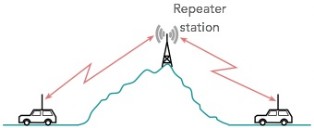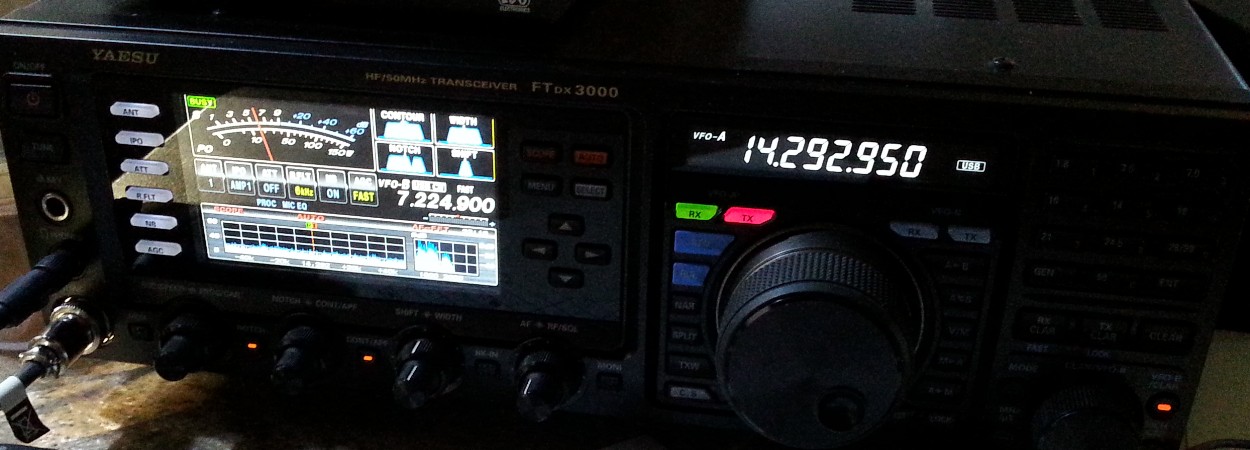rundown on the more common modes and features communications on the typical repeater
used in amateur radio. For more detailed information on the items listed, just click on the
hyper-link.
With UHF and VHF radios, the range of your signal only goes so far... If your using a handheld,
your range could be just over 10 miles on flat terrain. Enter the repeater. A repeater will take
your signal and as the name suggest, 'repeat' it. Where your signal only went 10 miles before,
it could go 60 or more miles with a typical repeater in the flat land of Florida. Most repeaters are
located on commercial towers or tall buildings with antennas often at 200 - 400 feet high. The
occasional repeater will have an antenna much higher, offering a very impressive coverage area, or
'foot print'. Not only are these repeaters on towers, but they are often running a power output
of 15 to 100 watts. Considering your typical handheld has a maximum power output of about 5
watts, you end up with a fantastic coverage area with it when used with a repeater. The
coverage of any given repeater varies from one to another. Differences in height, quality of
materials used, and repeater output power all have major bearing on the performance of a repeater.
Reference the diagram (to the right) of the two cars and antenna tower. Imagine those cars are
about 100 miles apart. Given that distance and the little hill between them, any signal of one station
is very unlikely to get to the other station using VHF or UHF. But with the repeater on top of the
tower, a signal from one is easily picked up by the repeater and re-transmitted for the other to hear.
Almost every transceiver has a squelch control. Squelch is used to 'quieten' received noise. With the
squelch all the way 'open', you will hear all the static and noise typical on our planet. Squelch can be
thought of like a 'gate' or 'levy'. Noise is always there, and we now have a gate to keep the noise out
(squelch control). We adjust the squelch control as one would the height of a flood gate on a dam.
The higher the noise/water level, the higher we adjust that gate to stop the flow of noise/water. If
you open that gate/squelch all the way, all that noise/water flows in.
Tone (PL or CTCSS = 'Private Line' or 'Continuous Tone Coded Squelch System')
Tone allows us another way of squelching out noise and unwanted signals. Most modern amateur
radios are equipped with 38 or more sub-audible tones for transmitting while your talking in order to
'open up' a repeater. While tones are considered to be 'Sub Audible', it's often heard if you listen
carefully. A tone value, which usually varies from 88 to 250, is used much like a key on a door.
Without the right key, that door remains locked. In our case, if the correct tone isn't being transmitted
(encoded), the repeater rejects the signal. This works great for times when a signal from a distant
repeater on the same frequency manages to come in range of our local repeater. That signal isn't
intended for our area and could be considered interference. Fortunately, it is customary for repeaters
that share the same frequency to use very different tones. Tones also keep other interference such as
lighting storms, dirty power supplies, and fluorescent lighting from causing the repeater to re-transmit the
noise. If a repeater is programmed for a PL tone of 100, then you need to program your radio to send that
same PL tone in order to take advantage of it's use. Many repeaters will not only decode your PL tone,
but they may also send out a PL tone as well. This doesn't have to be the same PL tone value but it
usually is. Having a repeater that sends out a PL tone with repeated signals is really neat as it allows us
to program our radios to reject all signals except when that signal has a PL tone too. Basically, your
sending a tone to unlock the repeater, and the repeater is sending a tone to unlock your radio. The tone
to be received is called Tone Squelch or Decode. When tone squelch is enabled on your radio, the squelch
knob has no real function or use as all signals are being rejected unless they include the proper tone.
While it is required to have a PL tone Encode programmed for most repeaters, it is not required to have the
tone squelch to receive it. You can leave the tone squelch off and still receive the signal if desired.
There are other methods to do the same job as PL tones, such as DCS - Digitally Coded Squelch, and
DPL - Digital Private Line for example. These operate with the same concept, only digitally instead of the
analogue tone.
Common Repeater Modes:
FM (Analog)
FM, or frequency modulation, is the most common method of transmission for repeaters in amateur radio.
For the sake of keeping things simple, we will keep the explanation to a minimum. FM is the same mode
used by your favorite FM music radio station. It is also commonly referred to as 'analogue'.
This is a fast growing digital mode. In fact, all three amateur radio repeaters in Wakulla County use this
mode (our repeaters work on both analogue FM and the digital C4FM/Fusion. It is a FDMA mode (Frequency
Domain Multiple Access). This mode includes a error correction mode that is superb at ensuring a clean
audio signal. PL tones are not used for digital modes. However DCS can be in some cases.
P-25, or Project 25, is a digital mode designed primarily for public service (Law Enforcement, Fire, EMS, etc).
It operates in similar form to the C4FM above, only P-25 is TDMA - Time Division Multiple Access. This
mode isn't very popular in amateur radio for our area, but it does exist. And like the Yaesu C4FM, P-25
works on FM as well. However, there is a P-25 phase 1 and P-25 phase 2. Phase 2 radios are backwards
compatible with phase 1 but phase one will not fully communicate with phase 2 equipment.
Like the P-25 above, DMR - Digital Mobile Radio is TDMA - Time Division Multiple Access. DMR was
developed in Europe but has been implemented all over the world. A DMR repeater is present in
Tallahassee for amateur use. It is not uncommon to talk with other amateurs in distant cities as many
DMR repeaters are connected together via the internet. With the correct 'code plug', one can connect at
will to a specific DMR repeater in a distant town or country to chat or listen. As with P-25, DMR has been
upgraded a few times over the years and the earliest equipment may not have full functionality or
compatibility. DMR incorporates an effective error correction for clean audio.
D-Star was one of the first digital modes to be offered commercially for amateur radio. This mode is based
on the MSK - Minimum Shift Keying method. Designed by a amateur radio group in Japan, the concept is
marketed by Icom International. This mode has been adopted by many for use in emergency and recovery.
Amateur radio groups in Alabama have coordinated with each other to develop a robust statewide D-Star
network. As with DMR, D-Star repeaters are often connected to the internet for repeater linking.
NXDN was designed by Icom (IDAS) and Kenwood (NEXEDGE) in a joint venture. It incorporates FSK
(Frequency Shift Keying) as well as FDMA (Frequency Domain Multiple Access). Clean audio and impressive
fringe performance is due to error correction. NXDN was also designed with Public Service in mind but has
also entered into the amateur radio arena.
Final...
This is a very short list and explanation of what choices one has with local repeaters. Unfortunately, one
digital mode isn't compatible with another. While two different modes may use similar methods such as
FDMA, several other things are much different like the codecs. Nor is it common to find two or more digital
mode capabilities on a single transceiver (we hope to see this change one day). In short, if you plan on
buying a digital mode capable rig, choose wisely. With three individual repeaters running the Yaesu System
Fusion - C4FM in Wakulla, it's a no brainier if you plan on spending most of your time in the area. That
being said, even though the local repeaters are YSF/C4FM, we typically use simple FM 99% of the time, so
picking up a radio that does not have digital capabilities if still a great choice.
But if you have a few friends using DMR in Tampa or Chicago, the DMR with the right code plugs may suite
you better. Or you can get both types! There are other modes and features available in addition to these.
Not all require digital means. One of the best decisions you can make would be to hook up with a local
amateur radio club to see what modes and methods are popular or preferred in your area, as well as have
the opportunity to see them in operation first hand. While it is required to pass an exam to talk on any
amateur radio devise, you won't be required to pass any engineering test to qualify for using a digital mode.
But knowing about the different types in your particular area can help make better decisions. FM is still the
most popular mode on VHF/UHF and likely will be for some time. And during an emergency or recovery, FM
is the best choice for local communications in most of Florida.
.


